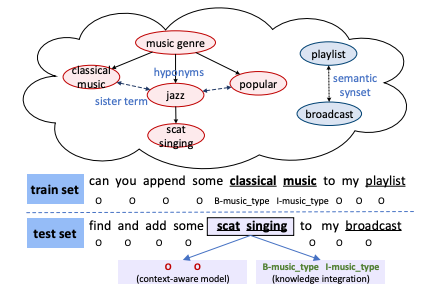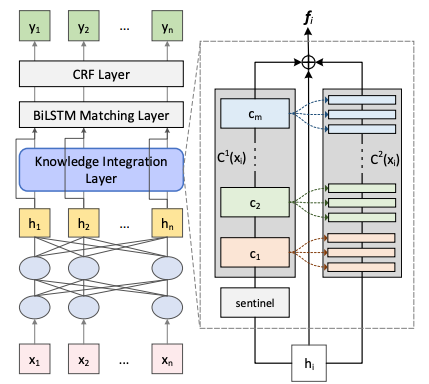OOV words often degrades the performance of slot taggers, which could be solved with extern knowledge like WordNet. This paper proposes a simple method to incorporate knowledge triples into BiLSTM taggers for tagging OOVs.

WordNet provides triples like a those in a Knowledge Graph which are expanded in two hops to create input triples. The subject and object embeddings are learnt by max-margin ranking. Given the hidden state of a token, these two levels of concepts are attended and concatenated to provide knowledge aware representations (the right part of the following figure).

Comments
- The methods are trivial and not very interesting. The relation embeddings are not learnt or used.
- The definitions of S_q and S_{q^\prime} are missing.
- The baselines are too weak. How about a BERT tagger with WordNet as gazetteers?
- The application of this method is quite limited as WordNet has not been updated for a long time. What happens if a token is OOV of WordNet?
Rating
- 5: Transformative: This paper is likely to change our field. It should be considered for a best paper award.
- 4.5: Exciting: It changed my thinking on this topic. I would fight for it to be accepted.
- 4: Strong: I learned a lot from it. I would like to see it accepted.
- 3.5: Leaning positive: It can be accepted more or less in its current form. However, the work it describes is not particularly exciting and/or inspiring, so it will not be a big loss if people don’t see it in this conference.
- 3: Ambivalent: It has merits (e.g., it reports state-of-the-art results, the idea is nice), but there are key weaknesses (e.g., I didn’t learn much from it, evaluation is not convincing, it describes incremental work). I believe it can significantly benefit from another round of revision, but I won’t object to accepting it if my co-reviewers are willing to champion it.
- 2.5: Leaning negative: I am leaning towards rejection, but I can be persuaded if my co-reviewers think otherwise.
- 2: Mediocre: I would rather not see it in the conference.
- 1.5: Weak: I am pretty confident that it should be rejected.
- 1: Poor: I would fight to have it rejected.
0 投票者
